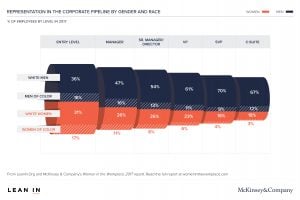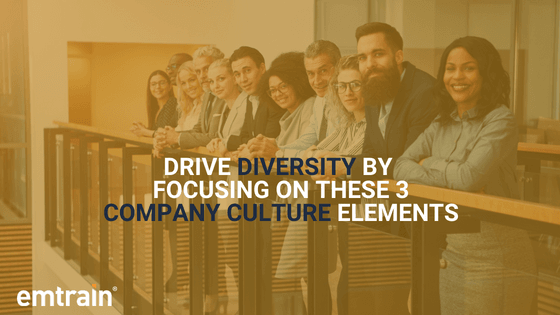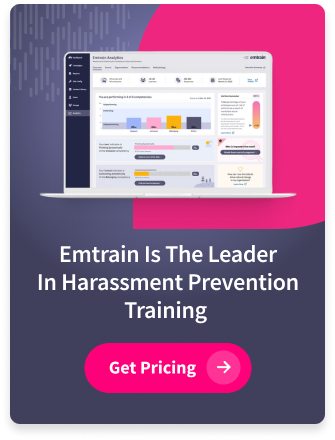If you’re working on diversity initiatives in the workplace you know it’s equally inspiring and frustrating. Research shows that companies with diverse talent pools achieve greater innovations, more productivity and higher profitability. So companies are spending hundreds of millions on diversity programs, yet getting very little return on their investment. Diversity numbers have increased only a percent or two—and in some cases, diversity is decreasing. As Google, Uber and Starbucks know, it only takes a leaked internal memo, a Medium blog or a YouTube video going viral to show the world the worst. For every two steps forward, we take a step back.
Scandals aside, why is there so little progress being made in recruiting and retaining diverse talent? If diversity is a focus, if talented people are holding dedicated diversity and inclusion roles, if the budget is being applied, why aren’t we seeing positive effects?
It comes down to two things: The Leaky Funnel and corporate culture.
The Leaky Funnel is a concept that explains how bias (conscious and unconscious) affects diverse candidates at three key points in their career: when being recruited, when navigating team dynamics and when in the promotion process. To drive positive change, organizations need to bring daylight to each of these areas, with structured processes and mini-interventions when things go wrong. We’ll share tips on each of these below.
Corporate culture, particularly an organization’s ability to accept, appreciate and admire diversity, is a bigger shift because complex human behavior and legacy tactics have already shaped the politics and power structure. Shifting from the status quo rocks the boat: some people will have to take a step back to let others ahead.
Leaders can’t just change their organizational culture. Cultures evolve, there’s no top down or bottom up magic to apply. Luckily, there are some good habits and cultural competencies that companies can promote so today’s employees can adopt to start the shift towards embracing diversity. We share some of these below too.
Improving Culture With Targeted Efficiency
In today’s competitive and fast-paced environment, companies don’t have a lot of time to experiment. Busy managers and individual contributors alike can focus on some key areas with impactful tactics that start to make a difference right away.
Recruiting with Diversity in Mind
For high-growth companies, hiring for open headcount is a fantastic opportunity to improve diversity numbers. Recruiting efforts have good leadership, ample budget and an array of external resources to find talent that hails from diverse backgrounds, whether that be academic backgrounds, ethnicity, race, or gender. A structured hiring process helps a company be efficient, and, when done right, can help keep bias out of the system.
For example, companies can:
- Articulate relevant qualifications for a role before beginning the candidate search
- Search from a wide swath of candidates, employing the Mansfield rule (version 2.0: a pledge that women, minority, and LGBTQ candidates will make up at least 30 percent of the candidate pool for promotions, senior-level hiring, and significant leadership roles.)
- Develop guidelines to evaluate candidates’ answers in advance of interviews (i.e., articulate what good, great and bad answers look like.)
- When interviewing multiple candidates for the same role, ask all candidates the same questions, and use a rubric to score candidates answers.
- Bring interviewers back together to discuss candidate scoring and agree on the final candidate
Structured interview processes are often successful…right up until the final decision. That’s where they, unfortunately, break down. Because of corporate culture, hiring managers often have a certain type of person in mind. They set aside this preference as they interview, as they narrow down the candidate list, and maybe even until they’re down to two candidates. Then the pressure’s on.
Knowing they’ll be judged on their decision, they look up their reporting line as they consider their choice. If their reporting line is a series of white male leaders, for example, perhaps they’ll feel more comfortable—and validated—bringing on the white male candidate. This may influence the interview team’s decision, or cause the manager to pull rank and make the decision on their own. Often it’s not done with harmful intentions. In fact, by rationalizing “it’s just this once” or “this is a really important hire, we have to get it right” the decision maker(s) may sacrifice diversity for the more obvious “cultural fit.”
So what to do?
First
The interview process needs oversight from an impartial HR, recruiting or diversity lead. They can bring the conversation back on track when it starts to go off the rails.
Second
Senior management needs to announce, socialize and reaffirm the desire for diverse hires. No one should feel that someone up their reporting line will second-guess them if they select the best person for the job and the candidate doesn’t look like everyone else. In fact, senior managers should proactively question their hiring managers when they see a pattern of sameness across new hires.
Third
Teams and individuals need to check themselves when they start to rationalize why selecting a non-diverse candidate isn’t right “this time.”
Team Dynamics That Encourage Diversity
Let’s say we’ve solved the recruiting process, and we’re getting lots of great, diverse candidates in the door. Do they onboard quickly, contribute broadly and thrive? Or is your company equally challenged with supporting and retaining those diverse candidates?
The old adage goes that people don’t leave companies, they leave bad managers. Of course, it’s a lot more complicated than that, but arguably, the manager has great influence over an individual’s sense of success, from helping match them with projects that play to their strengths, to giving recognition for a job well done or guidance when expectations are missed, to providing stretch opportunities and setting compensation to incent and reward them.
Team dynamics go beyond that: it’s the peer group of the formal “org chart” team and the interpersonal relationships and interactions with other colleagues who collaborate on projects and initiatives. These, plus employee resource networks and interactions with senior leadership all play into an individual’s sense of belonging at work.
Let’s look at one common culprit that can make people feel awkward and demotivated: meetings.
Every company has its own culture around meetings, and frankly, most aren’t great. Outrageously dysfunctional meetings have been the focus of everything from Dilbert cartoons to the popular “The Office” TV show. But more subtly dysfunctional meetings create situations that exclude and demoralize employees.
To level set, we’ll start with some common best practices that companies use to create meeting norms:
- Develop meeting agendas in advance
- Have protocols to ensure that everyone is heard
- Monitor interruption behavior
Why are these so important?
By planning an agenda and either distributing content prior to the meeting, or collecting afterthoughts following the meeting, you’re enabling introverts—half to a third of all people—to more fully participate. By monitoring and stopping interruption behavior you reorient the group to listen, and in many cases you enable women–who are more frequently interrupted, to participate more fully.
Why else might meeting agendas matter? Because people plan their days around the meetings they need to be in, and too often a forgotten contributor misses out. Imagine a meeting that unexpectedly comes around to a conversation about a big opportunity and a decision is quickly made. And now imagine the possibility of a mini-intervention “Hey, wait a second guys. This wasn’t on the agenda for today’s meeting. There are people who aren’t here who need to be involved in this decision. Shonda has the most experience and will have a ton to contribute. Let’s set up another meeting tomorrow when we can be sure to get everyone together to make this decision.”
Meetings often start with the best intentions, but can easily go off track. To be fair, in a fast-paced environment, organizations can hardly slow down to make sure that everyone is perfectly happy. But being a little more thoughtful doesn’t need to take much more time, and the impact can be great.
Career Advancement That Champions Diversity
When you’ve got the diverse candidates in the door and you’ve found ways to support them, the last hurdle is the promotion process.
How big is the hurdle? It depends on your organization, but if broad statistics are any indication, the hurdle is pretty high. Corporate pipeline research conducted by McKinsey & Company and LeanIn.org entitled “Women in the Workplace” shows how diversity statistics (by grouped categories: white men, men of color, white women, women of color) decrease at each corporate career stage, until white men dominate 67% of C-Suite roles.
 Just like in recruiting, a structured promotion process helps a company be efficient, and, when done right, can help keep bias out of the system.
Just like in recruiting, a structured promotion process helps a company be efficient, and, when done right, can help keep bias out of the system.
For example, companies can:
- Identify and document specific reasons for people-related decisions
- Make sure to hold people to consistent standards when evaluating performance
- Apply clear and consistent criteria when determining to whom to provide career opportunities
Fair and unbiased promotions are critical to ensuring that diverse talent has the opportunity to advance within an organization. But another element of the promotion process is equally important, because the way people get promoted, and the types of people who get promoted, reinforces a company’s culture in multiple ways.
Firstly, in some organizations, the promotion process is full of folklore and mystery. Stories of demanding clients, punishing projects, or near breakdowns often accompany the heroic ascent of chosen leaders. Even if the process isn’t that mysterious, things like who to get to know, who needs to know you, who really controls the promotion path, and how many people can get promoted this year, are all part of the chatter that happens at mid- and senior career levels.
Secondly, the people who get promoted—as a group and as individuals—send a signal to others about the types of leaders the organization values. It’s an indication of the styles and skills that are currently in favor with mid- and senior management.
Thirdly, the people who get promoted reconfirm the processes we’ve looked at here: recruiting, team leadership and advancement. They’ve made it through the process, and assuming they continue to advance, they’ll continue to influence how these processes run for many years to come.
As you contemplated these three points, you may have been thinking of the different impact that diverse and non-diverse candidates have on your corporate culture when they make it through the promotion process.
But it’s also worth considering the positive impact you can make by promoting people who value diversity. Notice we say promoting people who value diversity—and not diverse candidates. Though they may be one and the same, the modern leadership characteristic of embracing and empowering diversity can come from anyone—and valuing this characteristic in the promotion process reinforces the broader effort, while helping to evolve the culture and creating diversity expectations as the norm.
5 Steps to Patch Your Leaky Funnel
So, you’ve decided to patch up The Leaky Funnel in your company by concentrating on recruiting, team dynamics and the promotion process. You’re excited about how these ideas may help improve your diversity numbers and how they may also evolve your culture towards embracing diversity. How do you proceed?
- ROLL OUT structured processes for interviewing, team operating norms and the promotion process.
- REPEAT the reasons for the structured process often. Why are they important to your organization? How do they align with your company’s strategic goals? To attract the best talent, to better reflect our clients, to improve innovation, etc.
- REINFORCE good behaviors. Appreciate people who drive diversity. Celebrate more diverse hires, more equitable opportunity allocation, more diverse promotions—but provide targeted support to ensure effective onboarding, better retention and ensure success for new senior leaders.
- REDIRECT the behaviors that erode the above. When someone says “culture fit” when someone interrupts, when someone questions the competency of a newly promoted diverse manager, step in with mini-interventions and reiterate the benefits that come from a structured process.
- REAP the benefits. Enjoy the increased productivity, innovation and profitability that comes from building and maintaining diverse teams.
We know it’s not that easy. We know that for two steps forward sometimes we take a step back. But if companies continue to double down diversity efforts—and there’s every indication that they will—individuals have every incentive to figure out how to embrace and empower diversity. A structured process around recruiting, team dynamics and career advancement combined with mini-interventions when things start to revert to old cultural norms can help drive real change.
The people at the companies who get this right have the greatest opportunity ahead. Go get it.
To learn more about Emtrain’s Managing Unconscious Bias Program, which includes a 30-minute online course, data analytics, and microlessons, contact us.








